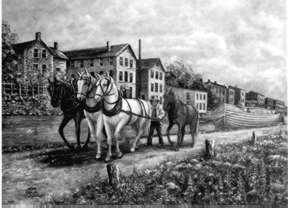|
|
|
|
©2008,
| |
| Clarion
Publications, Inc. All rights reserved | |
A (very) short history of the Erie Canal?
| | Crews of untrained men, without professional engineers to lead them, began digging-literally with picks and shovels. |
First there was a need- to move raw materials, people and manufactured goods from the Atlantic Ocean to the Great Lakes and then to ship the growing bounty of Western New York back to markets in the east. Then there was an idea-to build a canal through hundreds of miles of wilderness, swamps, mountains, waterfalls and tribes of sometimes hostile Native Americans. Some thought it a bad idea, among them President Thomas Jefferson. DeWitt Clinton, mayor of New York City, supported a route proposed by Geneva's Jesse Hawley, a miller. When Clinton became governor in 1817 he convinced the state legislature to finance a canal, and on July 4, 1817, crews of untrained men, without professional engineers to lead them, began digging-literally with picks and shovels-at Rome, N.Y. Eight years later, working through unimaginable obstacles, construction challenges and hundreds of kegs of whiskey, they ended up at Tonawanda Creek, near Buffalo. The canal they'd dug was 363 miles long, 40 feet wide and 4 feet deep. Its waters were carried across rivers by 18 aqueducts; 83 locks raised and lowered boats a total of 568 feet from end to end. The Erie Canal opened Oct. 26, 1825 at a cost of $7 million. Initially dubbed "Clinton's Folly," it immediately cut travel time in half. Shipping costs dropped 94 percent. |
According to WebCounter you are the
person to seek the Best of the West!
|

